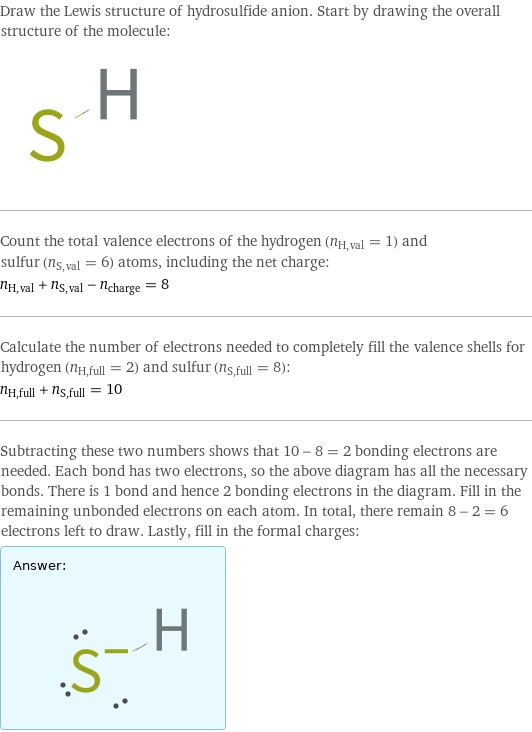Input interpretation

hydrosulfide anion
Lewis structure

Draw the Lewis structure of hydrosulfide anion. Start by drawing the overall structure of the molecule: Count the total valence electrons of the hydrogen (n_H, val = 1) and sulfur (n_S, val = 6) atoms, including the net charge: n_H, val + n_S, val - n_charge = 8 Calculate the number of electrons needed to completely fill the valence shells for hydrogen (n_H, full = 2) and sulfur (n_S, full = 8): n_H, full + n_S, full = 10 Subtracting these two numbers shows that 10 - 8 = 2 bonding electrons are needed. Each bond has two electrons, so the above diagram has all the necessary bonds. There is 1 bond and hence 2 bonding electrons in the diagram. Fill in the remaining unbonded electrons on each atom. In total, there remain 8 - 2 = 6 electrons left to draw. Lastly, fill in the formal charges: Answer: | |
General properties

formula | (HS)^- net ionic charge | -1 alternate names | bisulfide | sulfanide | hydrosulfide | hydrosulfide(1-)
Ionic radius

thermochemical radius | 207 pm
Units

Other properties

ion class | anions | biomolecule ions | ionic conjugate bases | polyatomic ions | ionic weak bases
Thermodynamic properties

molar free energy of formation Δ_fG° | aqueous | 12.1 kJ/mol (kilojoules per mole) molar heat of formation Δ_fH° | aqueous | -17.6 kJ/mol (kilojoules per mole) molar entropy S° | aqueous | 62.8 J/(mol K) (joules per mole kelvin)